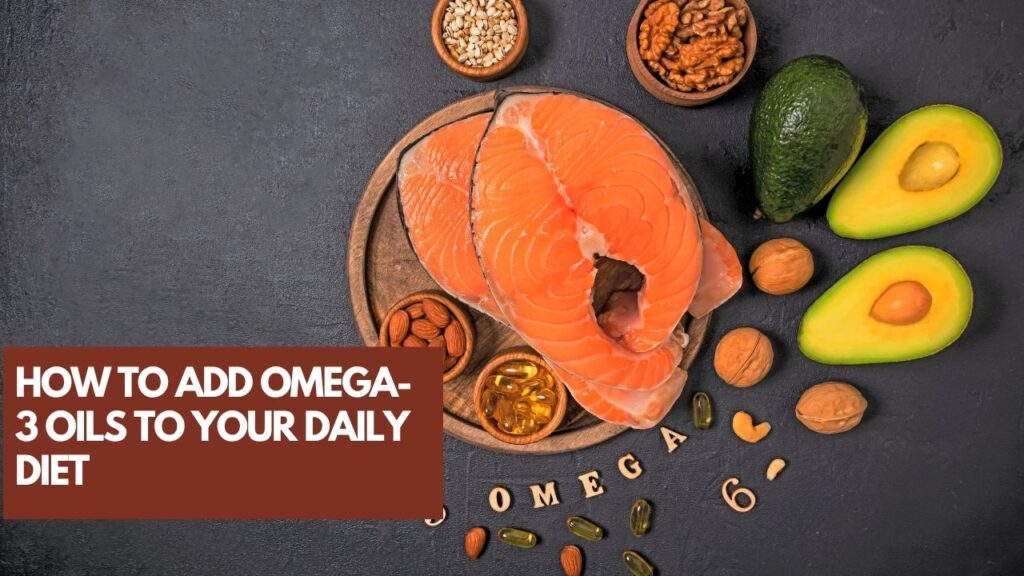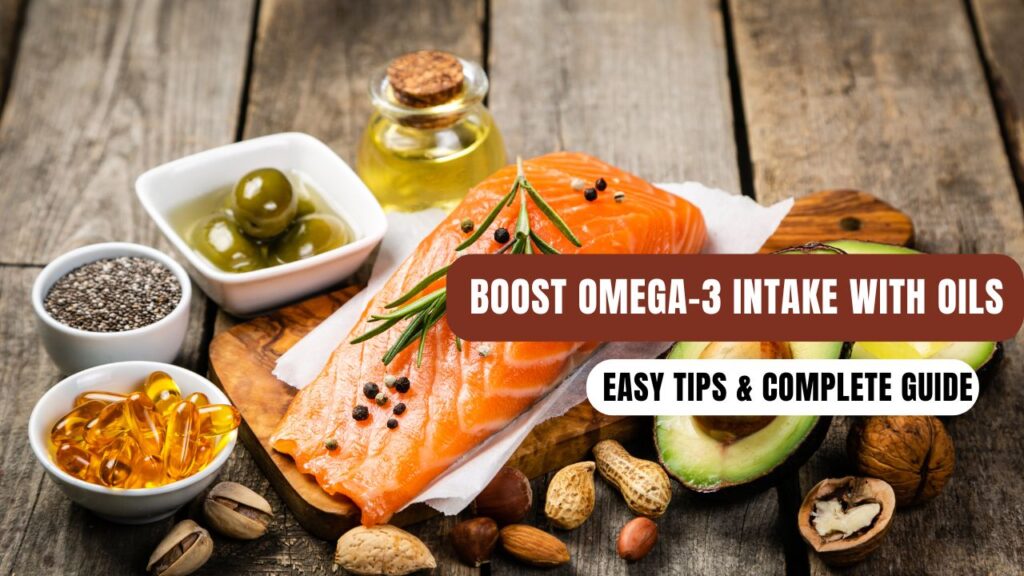Yes, you can naturally boost your omega-3 intake by choosing the right oils—and it’s easier than you might think. Omega-3 fatty acids are essential for our brain, heart, and overall well-being, but many of us aren’t getting enough in our daily meals. While fish is a well-known source, there are several plant-based and cooking oil options that offer a healthy, easy-to-use alternative—perfect for both busy weeknights and health-conscious routines.
In this guide, we’ll walk through everything we need to know about omega-3-rich oils—what they are, how they help, which ones are best, and simple ways to add them to our meals. Whether we’re making smoothies, sautéing veggies, or whipping up a salad dressing, the right oil can deliver a powerful nutrition boost with very little effort.
We’ll also answer common questions, compare oils, and offer practical tips backed by science and kitchen experience. By the end, we’ll know exactly how to make smart, tasty choices that support long-term health—without overhauling our pantry or diet.
Contents
Why Omega-3 Fatty Acids Matter
What Are Omega-3s?
Omega-3s are healthy fats that our bodies need but can’t make on their own. They help keep our heart, brain, and cells working well. There are three main types:
- ALA (alpha-linolenic acid): Found in plant oils like flaxseed and chia
- EPA (eicosapentaenoic acid): Found in oily fish
- DHA (docosahexaenoic acid): Also found in fish and algae
ALA is the most common in plant-based oils. Our body can turn ALA into EPA and DHA, though the process is slow. That’s why we need a steady supply of these fats every day. The National Institutes of Health explains this in detail.
Health Benefits of Omega-3
Adding more omega-3s to our meals helps in many ways:
- Supports brain health and memory
- Lowers the risk of heart disease
- Helps reduce joint pain and stiffness
- Fights inflammation
- Supports eye and skin health
According to Harvard Health, omega-3s also lower blood pressure and triglyceride levels. For people with busy lives or those watching their diet, using oils rich in these fats is a simple way to stay on track.
Best Oils High in Omega-3 Fatty Acids

Top Omega-3 Rich Oils (with comparison table)
When it comes to boosting omega-3s with oils, some options stand out. Each one has a unique flavor and best use. Let’s look at the top choices:
- Flaxseed oil: Very high in ALA. Best used cold in smoothies or dressings.
- Chia seed oil: High in omega-3s, with a mild taste.
- Walnut oil: Rich in ALA and great for salads.
- Hemp seed oil: Offers a balanced ratio of omega-3 to omega-6.
- Fish oil: High in EPA and DHA, but with a strong taste.
- Algae oil: A vegan-friendly DHA source with a clean flavor.
Table: Omega-3 Content per Tablespoon
| Oil | Omega-3 Type | Approx. Omega-3 (mg) | Best Use |
| Flaxseed oil | ALA | 7,260 mg | Cold dishes, smoothies |
| Chia seed oil | ALA | 5,000 mg | Drizzle on salads |
| Walnut oil | ALA | 2,500 mg | Dressings, baking |
| Hemp seed oil | ALA | 2,000 mg | Low-heat cooking, dips |
| Fish oil | EPA/DHA | 1,200 mg (EPA+DHA) | Supplement or softgel |
| Algae oil | DHA | 400–500 mg (DHA) | Smoothies, capsules |
These values may vary slightly by brand, so it’s good to read the label or check the source like the USDA FoodData Central for the most accurate information.
Choosing the Right Oil for Your Lifestyle
Cooking, Drizzling, or Supplementing?
Not all omega-3 oils are made for the stove. Some break down when heated. Here’s a quick way to pick the right oil:
- For raw dishes: Flaxseed, chia seed, and hemp seed oils are best
- For baking or low-heat sautéing: Walnut and hemp seed oils
- For high-heat cooking: Use oils with lower omega-3 (like avocado or olive) and add omega-3 oils after cooking
- For daily supplements: Fish or algae oils in capsule form
For more on how heating affects oils, the American Heart Association offers helpful advice.
Taste, Shelf Life, and Storage Tips
Omega-3 oils often have a light, nutty, or grassy flavor. Some, like flaxseed oil, can go rancid quickly if not stored well. Keep these tips in mind:
- Store oils in a dark glass bottle
- Keep them in the fridge once opened
- Use within 6–8 weeks of opening for best quality
Unrefined oils tend to spoil faster, so always check the date. If it smells “off” or fishy, it’s time to toss it.
How to Add Omega-3 Oils to Your Daily Diet

Simple Meal Ideas and Swaps
One of the easiest ways to get more omega-3s is to make small swaps. We don’t have to change our whole diet—just a few habits. Try these ideas:
- Use flaxseed oil instead of canola in salad dressings
- Add chia seed oil to morning smoothies
- Stir walnut oil into oatmeal for a nutty taste
- Drizzle hemp oil over roasted veggies before serving
- Mix algae oil into dips or hummus for extra DHA
- Replace butter with omega-3 oil in baked goods (only in no-heat or low-heat recipes)
These swaps keep the oil’s nutrients strong and make meals more heart-healthy. According to Cleveland Clinic, even one tablespoon of flaxseed oil can meet daily omega-3 needs for many adults.
Dosage Tips and Serving Suggestions
Here’s a simple guide to how much we should aim for each day:
| Group | Recommended ALA per Day | Oil Equivalent |
| Adult Women | 1.1 grams | ~1/2 tbsp flaxseed oil |
| Adult Men | 1.6 grams | ~2/3 tbsp flaxseed oil |
| Pregnant Women | 1.4 grams | ~1/2 tbsp chia seed oil |
| Children (1–3) | 0.7 grams | ~1 tsp walnut oil |
These values are based on guidelines from the National Institutes of Health. It’s best to spread intake across meals rather than all at once, to support better absorption.
Omega-3 Oils vs Supplements

Pros and Cons of Oil vs Capsules
There are two main ways to get omega-3s: through liquid oils or capsules. Each has its own benefits and drawbacks.
| Form | Pros | Cons |
| Liquid Oil | Easy to mix with food, faster absorption, natural form | Can spoil quickly, needs cold storage |
| Capsules | Long shelf life, no taste, precise dose | Slower to absorb, less versatile for recipes |
For people who don’t like oily textures or tastes, capsules might be easier. But for those who enjoy food-based wellness, oils offer more control and taste.
When to Use Each One
- Use liquid oils if we want to add omega-3s to meals or smoothies
- Choose capsules for convenience, travel, or picky eaters
- Consider algae oil capsules if we’re vegan or don’t eat fish
- Ask a healthcare provider if we’re unsure how much we need
For those with specific health goals, Harvard T.H. Chan School of Public Health has an excellent breakdown of supplement types and uses.
Common Questions About Omega-3 Oils (FAQ)
How much omega-3 do we need daily?
Most adults need between 1.1 to 1.6 grams of ALA each day. That’s about 1/2 to 2/3 tablespoon of a high-ALA oil like flaxseed. If we’re pregnant or breastfeeding, the need may be higher—talking to a dietitian helps.
Can we cook with omega-3 oils?
Some omega-3 oils break down under heat. Flaxseed and chia seed oils should never be used for frying or roasting. But hemp and walnut oil are more stable for low-heat cooking. Always check the label and store oils away from heat and light.
The USDA often lists smoke points and nutritional values for oils to help guide us.
What’s the best oil for picky eaters or kids?
Algae oil is a great option—it has a mild flavor and can blend into smoothies or yogurt. Chia seed oil is also very light in taste. For kids, even a small drizzle on toast or oatmeal can help. Capsules may work too, but always use child-safe brands.
Conclusion: Key Takeaways and Next Steps to Boost Omega-3 Intake
Boosting omega-3 intake with oils is simple and effective. Choosing the right oils like flaxseed, chia, hemp, walnut, or algae can provide essential omega-3 fats that support heart, brain, and overall health. Small daily swaps and smart serving sizes make it easy to add these oils to meals and snacks.
Remember to store oils properly to keep their nutrients intact and consider whether oils or supplements fit your lifestyle best. When cooking, use omega-3 oils carefully to avoid heat damage and maximize benefits.
Ready to start? Try adding a tablespoon of flaxseed or chia seed oil to your salad dressing or smoothie tomorrow. For more ideas, check out our free healthy meal planner, or tag us with #SmartKitchenEats when you share your omega-3-rich dishes!
For more expert advice on healthy fats, visit trusted sources like the Harvard T.H. Chan School of Public Health and the National Institutes of Health.


